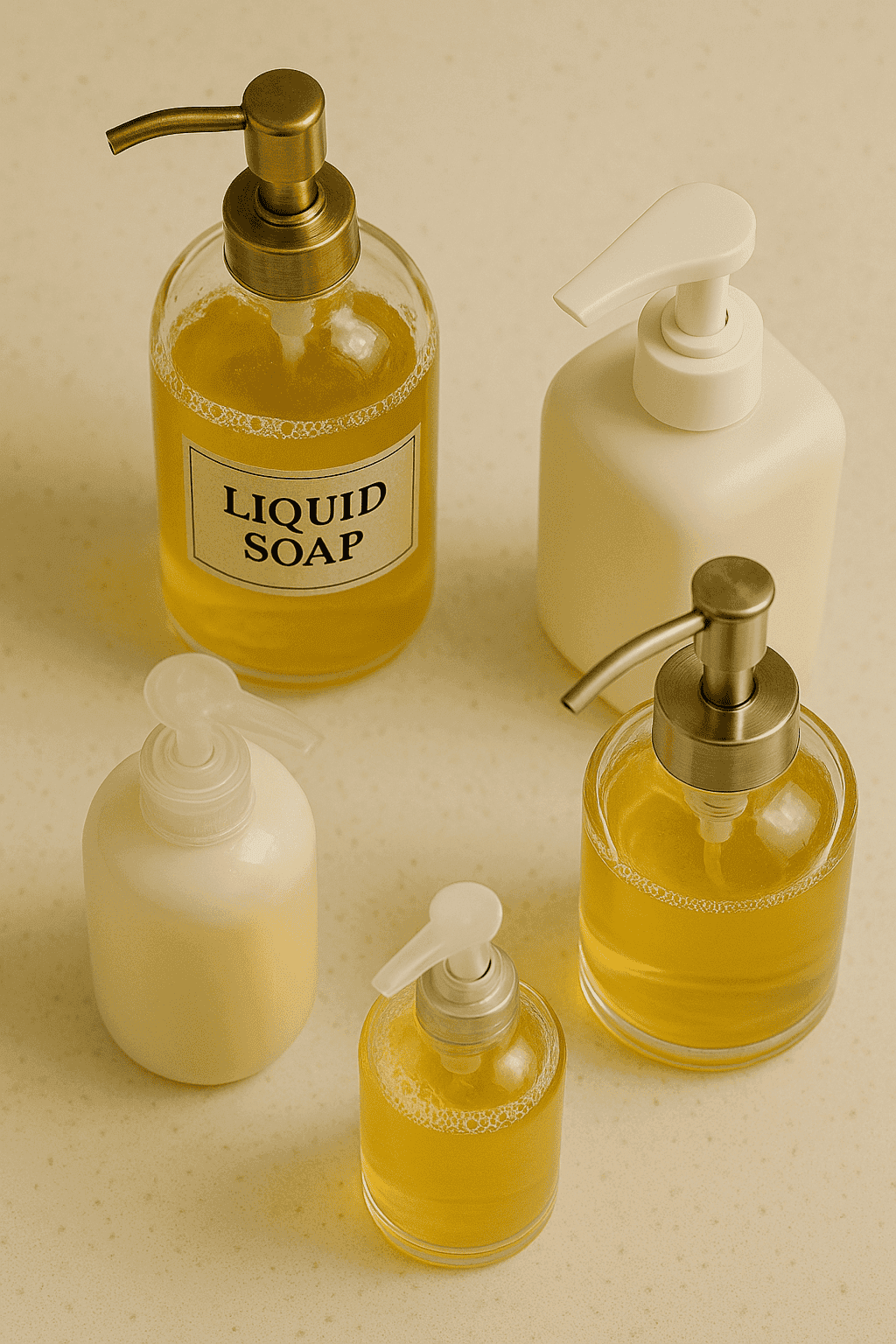How to Make Liquid Tallow Soap at Home 2025
I remember when I was new to soap making. I was looking for something unique, a soap made from a unique ingredient (I know that sounds funny, but that is what makes it special). That is when I learn about how to make liquid tallow soap at home. I was honestly surprised to learn that you could make soap from animal fat! And trust me, this liquid tallow soap is very easy to make.
So, I gave it a try and made my first batch of liquid tallow soap at home, and it turned out better than my expectations. It was gentle, moisturizing, and felt so satisfying to use something I made myself.
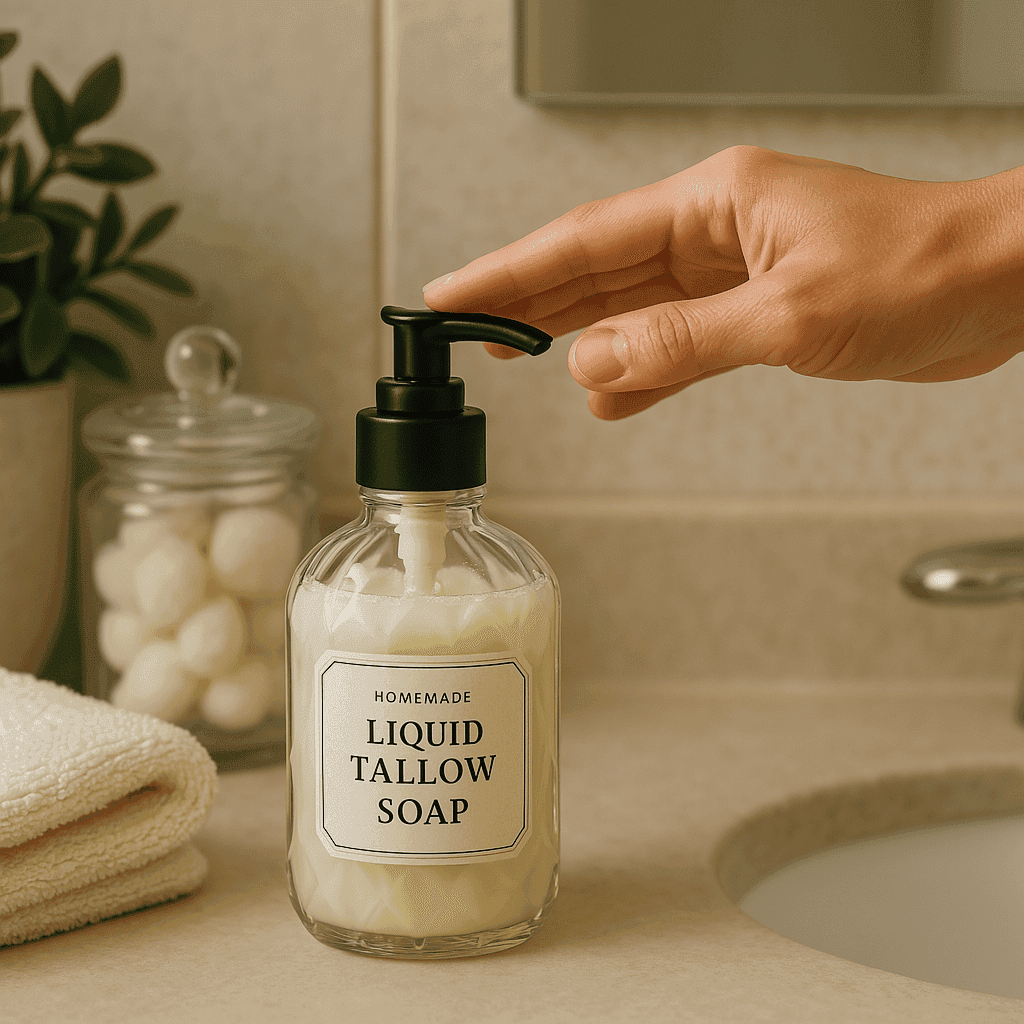
Just for you to know, this liquid tallow soap recipe is completely chemical-free, no synthetic ingredients and no harsh detergents. Just pure, natural goodness that is gentle on your skin.
Today, I want to guide you through the same process and show you step-by-step instructions on how to make liquid tallow soap at home. Let’s get started!
🐄 What Is Tallow Soap?
Tallow soap is made from beef fat (tallow) that has been cleaned and rendered.
People have used it for generations because it is super gentle on the skin, rich in nutrients, and very moisturizing.
While most homemade soaps are solid bars, this recipe is for liquid tallow soap, perfect for hand soap pumps, body wash bottles, and even foaming dispensers.
🧂 Benefits of liquid tallow soap
- Tallow is super moisturizing because it has vitamins A, D, E, and K. These nutrients will keep your skin soft, smooth, and healthy.
- It is also budget-friendly. If you cook at home, you might already have beef fat that can be turned into soap instead of throwing it away.
- Tallow is a traditional, natural ingredient that has been used for generations. It is simple and perfect for anyone who wants to keep things clean and natural.
- Plus, it helps reduce waste. Turning kitchen scraps into something useful like soap feels good and supports a more sustainable lifestyle.
🧼 Ingredients
In this recipe of Liquid Tallow Soap, we are going to use a hot process method to make a soap paste first, and then we dilute it to turn it into liquid soap.
Don’t worry, I will explain each step in simple words.
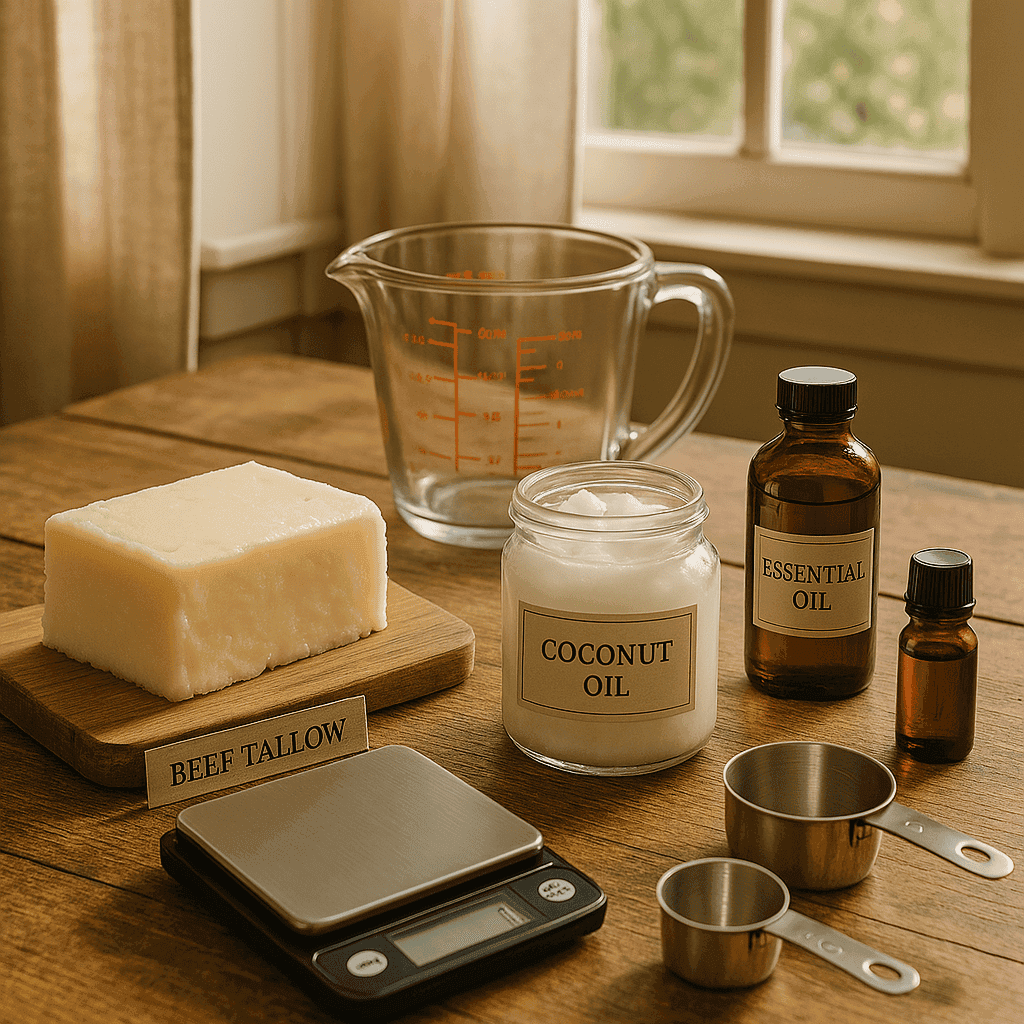
For the Soap Paste:
- 16 oz beef tallow (about 454 grams)
- 4 oz coconut oil
- 4.1 oz potassium hydroxide (KOH) – this is different from regular lye (NaOH), this is only used for liquid soaps
- 12 oz distilled water
For Dilution:
- 24 to 32 oz distilled water (adjust based on how thick you want the soap)
- Optional: 2 tbsp vegetable glycerin (for extra softness)
- Optional: Essential oils (like lavender, lemon, or peppermint)
Supply
- Slow cooker or crockpot
- Digital kitchen scale
- Heat-safe container
- Stainless steel or silicone spoon
- Stick blender
- Measuring cups/spoons
- Glass or plastic bottles/jars
- Funnel (optional, but helpful for pouring)
🧪 Safety is Important
Before we begin, here are a few important safety tips:
- Always add lye to water, never water to lye (it can splash and burn) (source).
- Wear gloves and eye protection.
- Work in a well-ventilated area or near a window.
- Keep kids and pets away while you’re making soap.
🍲 Step-by-Step Instructions For Liquid Tallow Soap Recipe
Step 1: Melt Your Oils
Start by placing your tallow and coconut oil into a slow cooker.
Turn it on low heat and let the oils melt completely. Stir from time to time to help them mix together perfectly.
This will usually take about 10–15 minutes. The goal here is to make sure the oils are fully melted and smooth, with no lumps, before moving to the next step.
Step 2: Make the Lye Solution
Now it is time to wear gloves and eye protection after taking precautions. In a separate heatproof container, carefully add the potassium hydroxide (lye) to the distilled water, never the other way around. Doing this slowly and in a well-ventilated area is important, as the mixture will heat up quickly and release some steam.
Stir gently until the lye is fully dissolved and the water looks clear. Once it is mixed, set it aside to cool for about 5 to 10 minutes. We wanted it to be warm, not steaming hot, when you combine it with the oils.
Step 3: Combine Lye and Oils
Once your lye solution has cooled a bit and your oils are fully melted, it’s time to mix them.
Slowly pour the lye solution into the melted oils in your slow cooker. Take your time and be gentle, no need to rush this part.
Now, grab your stick blender and start blending in short bursts. If you don’t have one, a spoon will also work.
Mix until the texture starts to thicken and looks like creamy pudding. This stage is called trace. It means everything is well-mixed, and your soap mixture is ready to move on to the next step.
Step 4: Cook the Soap Paste
Cover your slow cooker and let the mixture cook on low heat for about 2 to 3 hours.
During these 2 to 3 hours, your soap will go through a few strange-looking phases it might puff up, look grainy, or even gel a little. Don’t worry, this is totally normal!
Give it a gentle stir every 30 minutes or so to help it cook evenly and prevent it from sticking.
The texture should change into something like glossy mashed potatoes.
Once it reaches that point and no longer feels zappy or harsh (you can check by dissolving a small amount in water or using pH paper), it’s ready for the next step.
💧 Step 5: Dilute the Paste
Now, it is time to turn that thick soap paste into smooth liquid soap. Start by adding 24 to 32 oz of distilled water into the slow cooker with your soap paste.
Stir it gently, and keep the heat on low during this process.
This step takes time it might take a few hours for the paste to fully melt into the water. You can even leave it overnight with the lid slightly open to let steam out.
Once the soap is fully melted, it will look clear or a little golden. If you still see small chunks, just stir again or let it sit a bit longer until smooth.
Add glycerin and a few drops of your favorite essential oils once the soap cools a bit.
🧴 Step 6: Bottle It Up
After your soap is fully diluted and looks nice and clear, let it cool down completely.
Once it’s cool, use a funnel to carefully pour the liquid soap into clean bottles or jars.
That’s it, your homemade liquid tallow soap is ready to use!
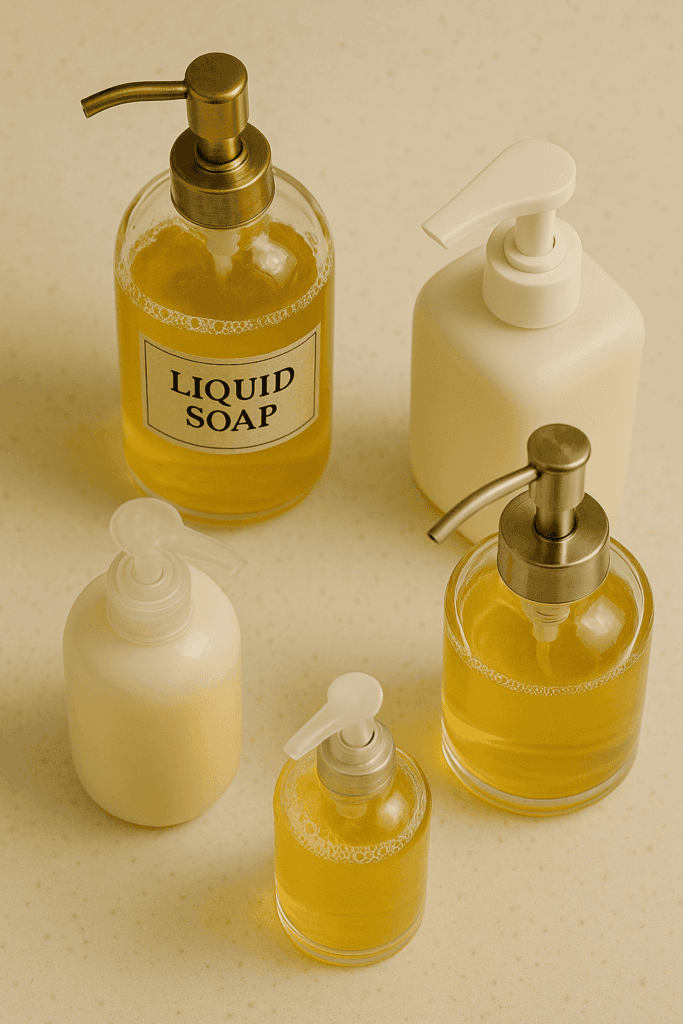
🌿 Option You Can Try
These are some extra ingredients you can try in a liquid tallow soap recipe, which will level up your liquid soap
- Lavender or peppermint essential oils are for fragrance and calm.
- Vitamin E oil will add moisture and help with shelf life.
- Aloe vera gel is for a soothing touch (add a small amount).
💡 Tips For Perfecting Liquid Tallow Soap
If your soap feels too thick after dilution, just add a little more distilled water a bit at a time until it becomes liquid-like.
Sometimes, homemade soap can separate after sitting for a while. Don’t worry about it, it is normal! Just give it a good shake or stir, and then it is ready to use again.
If your soap looks cloudy or has small pieces in it, you can strain it before pouring it into bottles to make it smooth.
🔍 FAQs About Liquid Tallow Soap Recipe
1. Is tallow soap safe for all skin types?
Yes! Tallow is super gentle and works especially well for dry or sensitive skin. If you have very oily skin, you can adjust the recipe slightly — just reduce the tallow a bit and add more coconut oil for a lighter feel.
2. Does tallow soap smell like beef?
Not at all! Once the soap is finished and you add your favorite essential oils, it smells fresh and clean. The natural scent of tallow goes away during the soap-making process.
3. Where can I get potassium hydroxide (KOH)?
You can buy it online or from soap-making supply stores. Just make sure it’s 100% pure and labeled as food or cosmetic grade — this is important for safety when following a liquid tallow soap recipe.
4. How long does homemade liquid tallow soap last?
If stored properly in a cool, dry place, your soap can last for several months without any problem. This is great if you’re learning how to make liquid tallow soap at home and want to make a big batch.
5. Can I use other oils with tallow?
Yes! While tallow is the star of this recipe, you can mix in olive oil, castor oil, or even sunflower oil to create different textures and benefits for your skin.
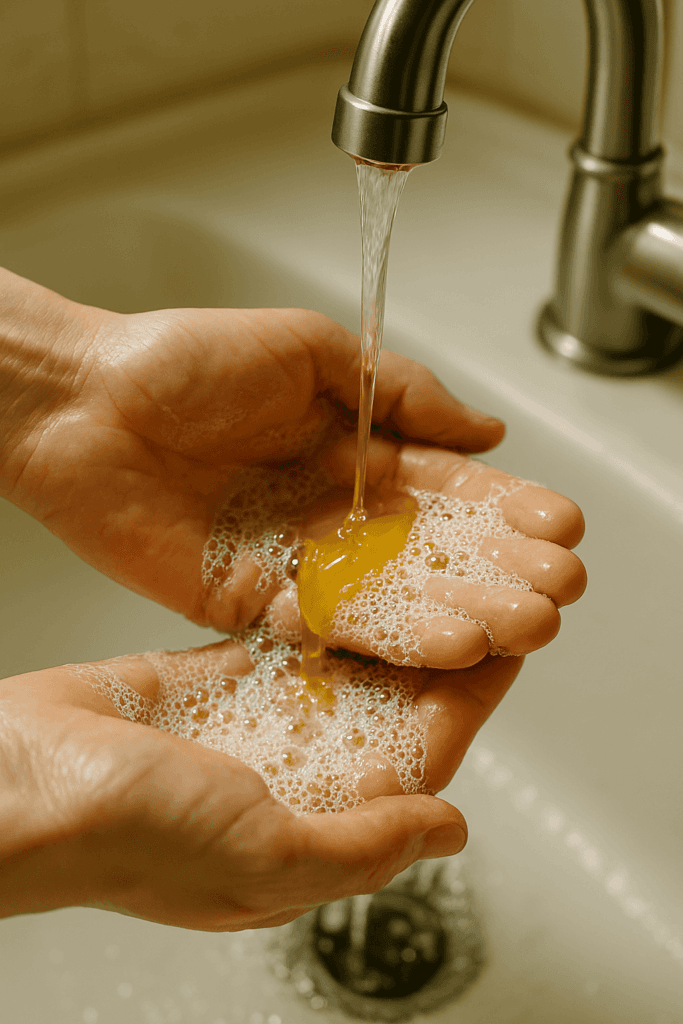
🎉 Final Thoughts
Making liquid tallow soap at home might sound tricky at first, but once you try it, you will see just how simple and satisfying it can be.
Plus, this liquid tallow soap recipe gives you get to control what goes into your soap — no weird chemicals, no fake fragrances, just natural, skin-loving ingredients.
It’s a great way to reduce waste, save money, and create something useful for your home. Whether you are just starting your soap-making journey or looking for a natural liquid soap alternative, this recipe is a great place to begin.
If you enjoy natural soap making, be sure to check out our Ultimate Guide To Coconut Oil Soap Recipe, Goat Milk Soap Recipe, and more!

Liquid Tallow Soap Recipe
Easy liquid tallow soap recipe using beef tallow and coconut oil. Learn how to make liquid tallow soap at home step by step!
Ingredients
- 16 oz beef tallow (about 454 grams)
- 4 oz coconut oil (adds lather)
- 4.1 oz potassium hydroxide (KOH) – used for liquid soap only
- 12 oz distilled water (to mix with the lye)
- 24–32 oz distilled water (add more for thinner soap)
- Optional: 2 tbsp vegetable glycerin (makes soap feel softer)
- Optional: A few drops of essential oils (like lavender or lemon)
Instructions
Step 1: Melt Your Oils. Add your tallow and coconut oil to the slow cooker. Turn it to low heat and let the oils melt fully. Stir every few minutes until smooth and completely liquid. This usually takes about 10–15 minutes.
Step 2: Make the Lye Solution on gloves and eye protection. In a well-ventilated area, slowly add the potassium hydroxide to the distilled water in a heat-safe container (never the other way around). Stir gently until fully dissolved. It will get hot, so let it cool down for 5–10 minutes before moving on.
Step 3: Mix Lye with Oils. Slowly pour the lye solution into the melted oils in the slow cooker. Blend with a stick blender (or spoon) until it thickens like pudding. This stage is called "trace".
Step 4: Cook the Soap Paste. Cover the slow cooker and cook on low for 2–3 hours. Stir gently every 30 minutes. It may puff up or look strange at first — that’s normal! When it looks like glossy mashed potatoes and no longer feels harsh (you can test a small piece in water or use pH paper), it's ready.
Step 5: Dilute the Soap. Add 24–32 oz distilled water to the cooked soap paste. Stir gently and keep the heat on low. It can take a few hours to dissolve fully. You can even leave it overnight with the lid slightly open. The soap will look clear or slightly golden when done.
Step 6: Customize (Optional)Once the soap has cooled a little, you can add glycerin for extra softness and essential oils for fragrance.
Step 7: Bottle and Store Let the soap cool completely. Use a funnel to pour it into clean bottles or jars. Store in a cool, dry place. It should last for several months.
Notes
- Tallow makes the soap creamy and moisturizing, which is great for dry or sensitive skin.
- Always add potassium hydroxide to water, never the other way, to stay safe during the soap-making process.
- If you're new and wondering how to make liquid tallow soap at home, just follow each step slowly. You’ll get the hang of it!
- Your soap might look cloudy or thick at first. That’s normal — it clears up as it dissolves fully.
- Store your finished soap in clean bottles, and it can last for months without any preservatives.
- Add essential oils or glycerin at the end to make your homemade liquid tallow soap smell nice and feel softer on the skin.
This blog post is based on my own experience and personal opinions. It’s meant for general informational purposes only and might not be right for everyone. It is not intended to replace professional medical advice, diagnosis, or treatment. Always talk to your doctor or a qualified healthcare provider if you have any health-related questions. Please don’t ignore or delay getting medical help because of something you read here. Thank You!
